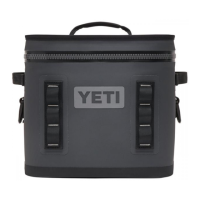PRO TIP:
MAXIMIZING ICE RETENTION
A YETI® Hopper™ Cooler, with its welded DryHide™ double-TPU coated construction, thick
ColdCell™ insulation, and waterproof HydroLock™ Zipper provides remarkable insulating
performance and ice retention capabilities.
To get the most from your YETI’s insulating qualities, we strongly recommend you read the
concepts outlined below. These techniques are used by seasoned outdoor professionals
who rely on extended ice retention.
Start with a cool YETI
®
Cooler
A cooler is designed to insulate, which
means it will retain heat as well as cold.
For this reason, try to store your cooler
in a cool environment prior to loading
it with ice. If stored in direct sunlight, a
warm garage, or a hot vehicle prior to use,
a significant amount of ice will be wasted
cooling the cooler itself. One way to cool
the walls is to pre-load it with a sacrificial
bag of ice. The starting temperature of
the cooler is one of the most commonly
overlooked variables in ice retention.
Dry Ice is the frozen form of Carbon Dioxide and its -109° F temperature makes a very attractive
cooling alternative to regular ice. Although the Hopper’s DryHide™ body construction is more
than capable of withstanding that extreme temperature, we still recommend against using Dry
Ice in the Hopper™.
Here’s why: instead of melting, dry ice sublimates into CO
2
gas as it warms. The Hopper, and
most notably the HydroLock™ Zipper, is so airtight that when fully closed, there is no way for
this gas to escape. The cooler will inflate until it bursts. Don’t try that at home!
Freeze or pre-chill contents
Chilling or even freezing the contents
you intend to load into your cooler is another
way to extend ice retention. Consider that it
will take over 1 lb. of ice to cool a six-pack of
room temperature beverage cans.
More ice is better
We recommend filling your cooler with as
much ice as possible. Ideally, we suggest an
ice-to-contents ratio of 2:1.
AVOID DRY ICE
Not all ice is created equal
Ice can get much colder than its freezing point. “Warm” ice (near 32°F) is typically wet to
the touch and dripping with water. Cold, sub-zero ice is relatively dry and will last
substantially longer.
32
o
21
o
0
o
WELL CURED ICE WARM WET ICE FREEZING POINT
o
F
8

